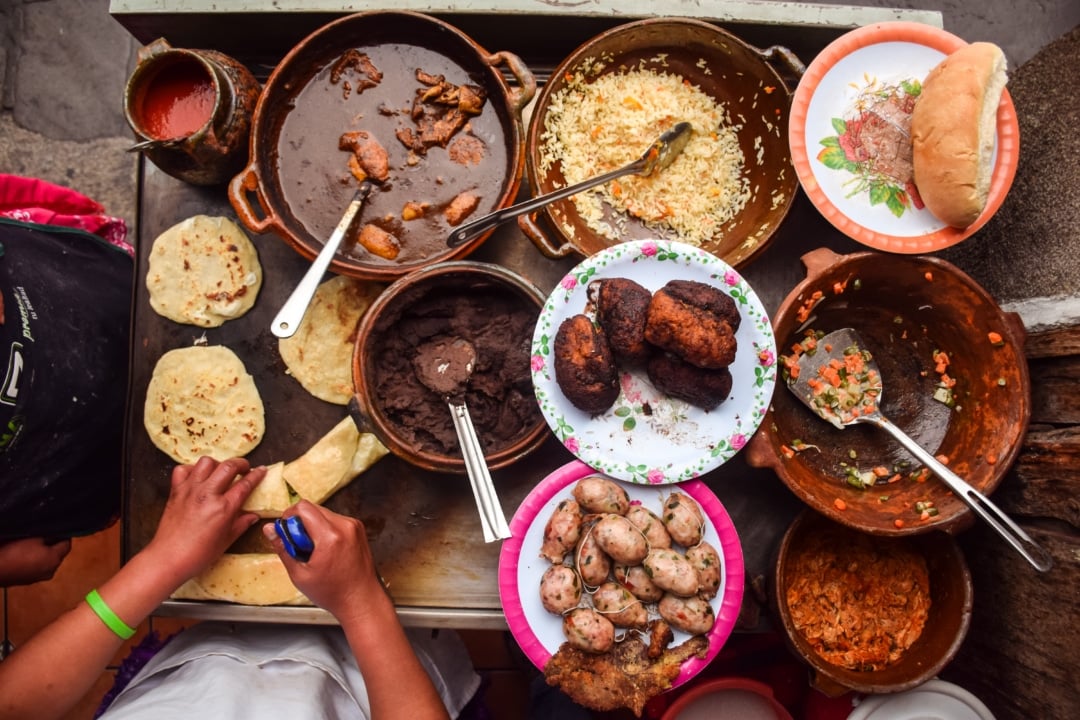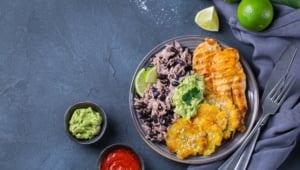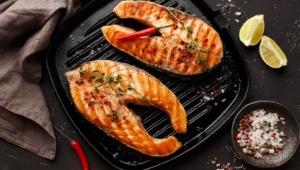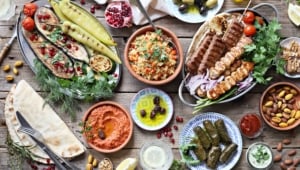Turkish Food: 12 Popular Dishes + 6 Secret Recipe Tips

Turkish food is delicious, healthy, and easy to prepare. These days, many people around the world are adopting this diet of the sultans. Let’s discover a few of Turkey’s most popular dishes – and learn the secrets to making those flavors pop.
Turkish is a popular takeout cuisine all around the world. But did you know that most Turkish people prefer to eat at home? Let’s learn the secret to healthy and delicious Turkish home cooking, and explore a few simple topics, such as:
- What traditional Turkish cuisine actually is
- The influence of Turkish cuisine on the world and the culinary innovations of the people of the Turkish diaspora
- The health benefits of this particular Mediterranean diet
- The top 12 Turkish dishes and drinks you ought to try
- Important ingredients
- Six culinary techniques you can use to take your Turkish cooking to the next level
- The eating habits and etiquette of Turkish dining
Let’s get into it.
Traditional Turkish Cuisine – More than Pide and Kofte

Traditional Turkish Cuisine – More than Pide and Kofte
Traditional Turkish cuisine has a rich and ancient history. The food of modern Turkey has its roots in the palace kitchens of the vast and powerful Ottoman Empire.
Ottoman sultans demanded meals of great variety, excellent taste, and high nutritional value to a warrior class. Modern Turkish cuisine reflects these same values, making it an extremely healthy and delicious option.
Turkish Food in The World

Turkish Food in The World
As early as 1529, Italians, Hungarians, Austrians, and German nobles were requesting Turkish cuisine to be served in their dining halls.
Traditional ‘German’ and ‘Hungarian’ sweets, such as Törökméz and Türkischer Honig are, in fact, derived from the Turkish koz halva. Even Börek (a classic Turkish pastry), can be found in Chinese cookery books dated as early as the 14th Century.
These days, Turkish food continues to be served globally. However, most Americans will be more familiar with street food versions of this ancient cuisine. The association of Turkish cuisine with street food is pretty recent – originating in 1970s Germany.
The German post war economy was characterized by massive labor shortages. In an effort to meet this shortage, Germany welcomed tens of thousands of Turkish working people.
This was a very effective solution for the German economy. Unfortunately, for the Turkish laborers, the market crashes of the 1970s led to catastrophic rates of unemployment amongst working class people.
Without other employment opportunities, many Turkish expats began their own businesses. A number of these entrepreneurs turned to the rich culinary tradition of the former Ottoman Empire for inspiration. Blending Turkish cuisine with German efficiency, these early restaurateurs pioneered the döner kebab.
As it turned out, the German appetite for Turkish food was just as veracious in the 1970s as it was in the 1520s. Before long, döner kebab had become not only famous in Germany but throughout the world.
While this iconic street food deserves recognition, in truth, the döner only represents a tiny fraction of what Turkish cuisine has to offer.
How Healthy Turkish Food Is

How Healthy Turkish Food Is
Historically, the monarchs of Western Europe ate foods that flaunted status – heavy in expensive commodities like butter, cream, and red meat. In stark contrast, the Ottoman sultans enjoyed a diet that delighted the senses and nourished the body.
Modern Turkish cuisine reflects the priorities of the sultans. Turkish food is seasonal, based on fresh ingredients, and makes extensive use of vegetable components. Dishes are designed to be balanced and nutrient-rich – without sacrificing flavor.
Grilled/Baked/Boiled

Grilled/Baked/Boiled
Turkish food requires competency with several different methods of preparation. Grilling, baking, boiling, and deep frying are all important Turkish cooking techniques.
Mastering these methods allows you to build meals with varied textures and flavors. Using multiple preparations allows you to highlight the different qualities of many ingredients.
Lean Protein Sources
Legumes such as chickpeas are an important vegetarian protein source in Turkish cuisine. Historically, meat was eaten infrequently. These days, many Turkish chefs make frequent use of lean meats, such as chicken. Other meats, such as lamb, are also a big component of traditional Turkish cuisine.
Plenty of Vegetables

Plenty of Vegetables
Turkish cooking is all about the vegetables. Celebrating seasonal vegetables is an extremely healthy and sustainable way to eat. Making vegetables the heroes of your dishes encourages creativity and teaches you how to build flavor from the ground up.
A strong focus on vegetarian options generally indicates a sophisticated cuisine and a high level of competence among its chefs.
Use Healthy Fats
Traditional cuisines are built for well-being. Turkish food focuses on balanced nutrition – meeting dietary needs for proteins, fats, carbohydrates, vitamins, and minerals.
While fats get a bad rap in popular culture, they are actually extremely important to physical health and well-being. Reputable nutritionists know this – don’t believe any Instagram ‘wellness’ influencer who tells you otherwise.
Herbs and Spices

Herbs and Spices
Turkish cuisine has its own distinctive array of herbs and spices – as well as traditional mixes and combinations. Allspice, anise, black pepper, cardamom, cinnamon, clove, coriander, haspir, isot, mahlep, mastic, and cumin are all commonly used.
Fenugreek, nigella, red pepper, rose water, poppy seeds, saffron, salep, sesame seeds, and sumac are also important herbs and spices.
Moderation Is Key
As with any traditional cuisine, the trick is balance and moderation. Eating a wide variety of ingredients and preparations is an excellent way to meet your nutritional requirements.
Eating too much of any one thing can lead to poor health. Eating seasonally, and serving traditional meals, will help you learn how to moderate and balance your diet.
12 Famous Turkish Dishes You Have to Try

12 Famous Turkish Dishes You Have to Try: Yayla Çorbası
If you are new to Turkish cuisine, it can be daunting trying to decide where to start. There is a huge variety of Turkish dishes, and honestly, they are all delicious. However, you have to begin somewhere, so here are a few beginner recommendations.
Soups
Soups are served with most meals – including breakfast. If you’re going to learn to cook Turkish, you will need to master at least one soup recipe. Below, we explore two of the most popular soups in Turkish cuisine: Yayla Çorbası and Mercimek Çorbası.
Yayla Çorbası

Yayla Çorbası
Yayla Çorbası is an excellent soup to begin your education in Turkish cooking with. This is a popular dish. Variations of this delicate soup are served throughout the Arab world.
Rice, yogurt, and a selection of herbs are combined to create Yayla Çorbası. The yogurt component brings a pleasant sourness. Rice, combined with the fats of the yogurt, makes this soup decadently creamy. Variations in spice or herb flavorings normally include parsley, purslane, and mint.
Mercimek Çorbası
This soup is made from creamy lentils. It is a wonderful high-protein vegetarian option, and a great recipe to get into regular rotation at home. Seasonings include cumin and coriander, red pepper, and salt.
For aromatics, sauté onions, and garlic. I always add a dash of lemon juice to this soup – it brightens the flavor and brings the other ingredients into sharp relief. This dish is a total comfort food – warming your heart and your belly.
Salads

Turkish Salads – Çoban Salatası
Salads are a ubiquitous part of Turkish cuisine. They sometimes include a grain component and are flavored with fresh herbs. Although not exclusively Turkish, many readers will already be familiar with tabbouleh, for example.
Çoban Salatası
Çoban Salatası is known as a ‘shepherd’s salad’ in Turkish. This dish celebrates the crisp clean flavors of fresh garden vegetables. Finely chopped and peeled tomatoes are combined with cucumbers, green peppers, parsley, and onions. It is dressed very simply with olive oil, lemon, and salt.
Piyaz
This salad is a wonderful protein-rich, vegetarian, option. The flavors are bright and tangy – enhanced by a lemon and sumac dressing.
The traditional ingredients of piyaz are olive oil, sumac, lemon, parsley, red onion, garlic, cannellini beans, and tomatoes. The cannellini beans add a protein hit to this fresh and delightful salad.
Starters, Sandwiches, Sides

Starters, Sandwiches, Sides
This is a bit of a catch-all category. There are simply so many different types of Turkish food. It seems sensible to group some of the smaller dishes, sides, and snacks together here, so you can explore all the variety that’s on offer.
Dolma
In Turkish, ‘dolma’ simply means stuffed. Ingredients for stuffings include minced meat, rice, fruit, offal, or fish. This style of dish dates back to the days of the Ottoman Empire. These fillings can be stuffed into various vegetables.
Grape, cabbage, and other leaves are also frequently used to wrap fillings. When dolma fillings are wrapped, they are referred to as ‘sarma’. Sarma is categorized as dolma, but internationally you will often see the two terms used interchangeably.
Patlıcan Kızartması

Patlıcan Kızartması
This fried eggplant dish is eaten daily in the summer months. Eggplants are a special vegetable in Turkish cuisine. After tasting patlıcan kızartması, you will understand why. This beautiful fried eggplant dish is generally enjoyed with garlic yogurt and a crushed tomato sauce.
Patlıcan kızartması has been a staple of Turkish cuisine since the days of the Ottomans. The summer months were even referred to as ‘fried eggplant months’ because the dish was so ubiquitous.
The old story goes that, at this time of year, house fires were remarkably common. This was believed to be due to the frequency of eggplant frying-associated fires, wooden homes, and the dry climate.
Mains
These dishes are the heroes of your meals. Each main dish has its own traditional accompaniments. Don’t feel constrained by this though. Good Turkish meals are characterized by abundance and eclectic offerings.
Adana kebab

Adana kebab
Adana kebab is made from hand-minced meat and the tail fat of a lamb. This mince is seasoned with salt, sweet red peppers, and, occasionally, garlic. The seasoned meat is pierced with an iron skewer and barbecued over flame-less oak coals.
During cooking, fat is dabbed off the meat with flatbreads – which are warmed and flavored in the process. The Adana kebab is then served on the flatbreads used while cooking. Adana is best enjoyed with a charred tomato and pepper paste and garnished with an onion, sumac, and garlic medley.
Lahmacun
In English-speaking countries, lahmacun is frequently referred to as ‘Turkish Pizza’. This is due to the thin crispy flatbread that the toppings are wrapped in. This dish consists of minced and spiced beef or lamb, roasted eggplant, pickles, and minced vegetables.
Aromatics include onion and garlic. Herbs and spices such as chili pepper, parsley, and paprika are common additions. Tomatoes, red peppers, and lettuce are delicious in lahmacun – when they are in season.
Bread, Pastries, Dessert

Bread, Pastries, Dessert
Turkish delight and baklava are delightful. But there is a lot more to Turkish sweets, pastries, breads, and desserts than just those two dishes. Let’s see what other Turkish sweets and breads you might enjoy.
Simit
Simit is a crunchy chewy delicious ‘Turkish bagel’. This bread is firm and round, and coated in sesame or poppy seeds. Simit has been served since at least the Middle Ages and is baked from fine white flour. It is a common street food, and is frequently consumed with sweet jam, cheese, and tea.
Ekmek

Ekmek
Ekmek is a recipe from the old Ottoman Empire. These days, Turkish people consider it to be a specialty of the Afyonkarahisar region of Turkey. Ekmek bears some resemblance to the common English dessert, bread pudding.
Day-old bread is used in the preparation of ekmek – giving a new life to a stale product and reducing waste. In Turkey, ekmek can be purchased ready-made. International chefs will have to prepare this comforting dessert from scratch.
Traditionally, ekmek is prepared by soaking the hollow crust of a dry loaf in caramel şerbet. The loaf is then stuffed with ice cream or, more traditionally, a type of Turkish clotted cream. There is a modern version of ekmek that doesn’t make use of day-old bread, and it is prepared more like a baked cake.
Secret Recipe Tips

Secret Recipe Tips
These secret tips are taken for granted by Turkish chefs. Try to apply each of these techniques when you are cooking – the results will speak for themselves.
Toast Spices First
For Turkish cooking, you want to begin with a number of whole dry spices. These spices should be toasted in a dry pan – before they are ground and added to dishes. Toasting spices is an effective way to deepen and strengthen their flavor.
Some dishes use whole spices, while others use ground. Either way, you should make a habit of toasting your spices before using them in your cooking. You might think it’s a good idea to bulk toast in advance. I would advise against this. Freshly toasted spices have the strongest and most pleasant flavor.
Use Different Sweeteners

Use Different Sweeteners
Although cane sugar has a place in Turkish cuisine, alternative sweeteners are commonly used. Honey is an easily accessible alternative to sugar – it also brings rich, warm, and somewhat floral flavor notes. You will find many Turkish recipes that make use of it.
Dried fruits, particularly dates, can be used in Turkish dishes to add sweetness and complexity to a meal. There is also a traditional Turkish sweetener known as pekmez. Pekmez has been a part of Mediterranean cuisine since the time of the ancient Greeks, and later Romans.
Pekmez can be purchased as a ready-made ingredient, or it can be prepared in bulk in your own kitchen. Fruits are reduced into a sweet and complex highly-concentrated syrup.
A variety of seasonal fruits can be used, to achieve slightly different flavor profiles. As well as sweetness, pekmez often has a somewhat sour or tangy taste. This sourness can enhance your dish, or be mellowed with the addition of calcium carbonate to the pekmez reduction.
Add a Touch Of Acid

Add a Touch Of Acid
Regardless of cuisine, cooking is all about balancing and hitting six basic notes: sweet, fat, sour, salty, savory, and acid. Every culture and cuisine has different go-to ingredients and components for bringing out and balancing the fundamental six flavors. Turkish cooking is no exception.
When it comes to acidity, there are several ingredients used in Turkish cooking. First off the bat, we can use a particularly acidic pekmez.
This ingredient has the advantage of contributing sweetness and acidity to a dish. Sumac is another commonly used ingredient that bumps up the acid in Turkish cooking.
Sumac is a bright red fruit that is dried and ground for use in cooking. It is used in cuisines throughout the Arab world and west into the rest of the Mediterranean.
Did you know?
This spice is a central ingredient in the spice mix ‘za’atar’, dating back to biblical times. Sumac also features heavily in the medieval cuisine of royals in Western Europe – themselves strongly influenced by the Ottoman Empire.
Use Various Cooking Techniques

Use Various Cooking Techniques
Turkish cuisine is varied and ancient. Across the ages, Turkish chefs have used and perfected many different cooking techniques.
Various techniques (toasting, steaming, baking, rotisserie, roasting, grilling, BBQ, etc, etc) bring different textures and flavors out of your ingredients. Familiarize yourself with the techniques used in Turkish cuisine – don’t be afraid to branch out and try something different.
Add a Pinch Of Salt
If you feel like something’s missing, add salt. Salt is a natural flavor enhancer. In small quantities, salt enhances sweet, sour, and savory notes.
In larger quantities, it suppresses sweetness and enhances savoriness. Half the time, when your dish tastes under-seasoned or bland, all you need to do is add a pinch of salt.
Use Quality Ingredients
Good food is made from quality ingredients. But what does ‘quality’ mean when it comes to Turkish cuisine? You don’t have to break the bank when it comes to cooking Turkish.
Turkish cuisine is focused on seasonality and freshness – so you should always be using vegetables when they are readily available.
Beverages

Beverages
You probably think of tea and coffee, when imagining Turkish beverages. Both of those beverages are held dear in the hearts of Turkish people. However, another drink also commonly enjoyed in Turkey is known as ayran.
Çay
Turkey exports a fifth of the world’s tea leaves. Turkish people are known to drink more tea per capita than any other group. On average, a Turkish citizen consumes a staggering three kilograms, or more, of tea every year.
Turkish tea is known as Çay. Çay is taken either ‘strong’ or ‘weak’ and is served with cubes of beet sugar. You can enjoy the delightful crimson color of the tea when you drink it from traditional glass Turkish tea cups.
Türk Kahvesi

Türk Kahvesi
In English, we refer to Türk kahvesi as ‘Turkish coffee’. Many of us are familiar with this sweet, dark, and invigorating beverage. Turkish coffee has more in common with plunger coffee when it comes to preparation, but its mouthfeel and density of flavor is reminiscent of espresso.
This quintessential Turkish beverage is made by boiling ground coffee in a cezve (small copper pot). Türk kahvesi is served unfiltered, in small ceramic cups, often with generous helpings of sugar. Many Turkish people enjoy türk kahvesi after finishing breakfast.
Ayran
Yogurt, water, salt, and, sometimes, mint are combined to create a crisp refreshing glass of ayran. This simple drink is rich in electrolytes and has been consumed by various peoples since times before history. In Turkey, it is often served alongside rice and meat.
Typical Ingredients in the Turkish Cuisine

Typical Ingredients in the Turkish Cuisine
These are far from the only ingredients in Turkish cuisine. However, you will notice them as components in many Turkish dishes. If you want to get good at cooking Turkish, you need to stock up on the following ingredients.
Eggplant
Eggplant has little of its own flavor but is fantastic for soaking up sauces, spices, and oils. In Turkish cuisine, eggplant is prepared in a range of different ways. Eggplant can be stuffed with meat or vegetables, as is the case with karnıyarık or İmam bayıldı.
Alternatively, eggplant can be cut up, deep fried, and served with or without yogurt – as patlıcan kızartması or patlıcan şakşuka. Eggplant can also be charred, peeled, and blended with tahini, garlic, lemon, and seasonings, to prepare creamy babaganuş.
Lamb

Lamb
Traditionally, Turkish people are not big meat eaters. Turkish cuisine is based around vegetable dishes, and meat is a ‘sometimes’ ingredient. When meat is used, lamb is often preferred. There are many different preparations of lamb in Turkish cuisine.
Lamb has a strong gamey flavor and a high fat content – making it a very succulent meat when prepared correctly.
Outside of Turkey, lamb is often associated with döner kebab (a dish born from the Turkish diaspora in Germany). Kuzu çevirme (milk-fed lamb) is traditionally cooked on a spit for special occasions, although it is less common these days.
Yogurt

Yogurt
Most traditional cuisines serve a fermented or cultured component as a part of every meal. These kinds of foods promote good gut health and are generally beneficial. In Turkish cooking, yogurt fills this role.
Yogurt is deeply associated with Turkish cuisine. The word for yogurt in many languages (including English) is actually derived from the Turkish ‘yoğurt’.
In Turkish cooking, yogurt accompanies almost all meat dishes, is eaten with bread, and is prepared as a refreshing beverage, ayran. Yogurt is also used in Turkish baking, and as an ingredient in soups.
Tomatoes
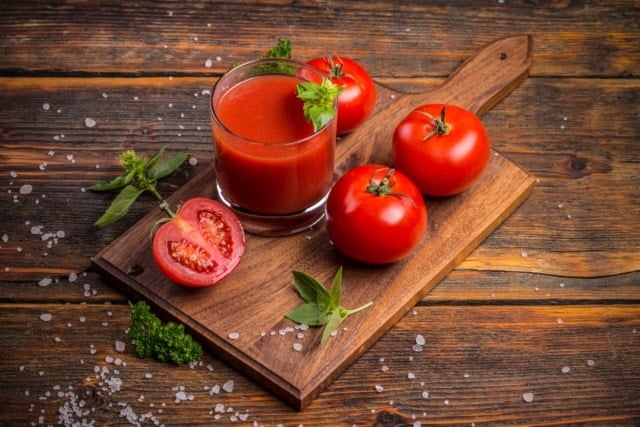
Tomatoes
Tomatoes were introduced into Turkish cuisine after the catastrophic European invasions of the Americas in the late 15th century.
Like many other parts of the Old World, tomatoes were embraced by chefs and gardeners in the Ottoman Empire. It’s hard to imagine modern Italian, Indian, or Chinese cuisine without tomatoes – and the same goes for Turkish food.
Chickpeas
Meat isn’t an everyday component in Turkish cuisine – instead, legumes like chickpeas provide ample protein at meal times. Chickpeas are a key ingredient in the ubiquitous hummus (which simply means ‘chickpea’ in Arabic). They can also be cooked with rice, making a ‘nohutlu pilav’.
Bulgur Wheat

Bulgur Wheat
Bulgur is a type of cracked wheat grain. It can be cooked, par-boiled, or simply soaked in water, before consumption.
It’s a primary ingredient in Kısır (tomato and parsley salad), Kibbeh (fried, grilled, or raw balls of bulgur), and Tabbouleh. Bulgur often substitutes rice or wheat and has been a popular ingredient since the middle ages.
Herbs and Spices
There are many herbs and spices used in Turkish cuisine. However, stocking up on these basic flavorings will get you a long way in your Turkish cooking journey.
- Cumin: used toasted, whole, or ground
- Mint: this herb grows like a weed in almost any kitchen garden
- Sumac: adds a tangy acidic flavor and a bold red color
- Red pepper flakes: bumps up the heat in any dish
- Paprika: a sweet smoky spice with a brilliant red color
- Dill: a distinctive and slightly astringent herb
Turkish Food Culture

Turkish Food Culture
The way you eat food is almost as important as the food you are eating. Every cuisine, and its associated cultures, follow different habits, etiquettes, and routines.
Eating Habits
These are the eating habits you may want to adopt if you are trying out Turkish cuisine. This way, you can best understand the thinking behind different meals and the way they are eaten.
Three meals daily, breakfast is important
Breakfast is the biggest meal of the day in Turkish cuisine. This ensures that the members of a Turkish household are well-fuelled and energized for the day ahead. There should be a large variety of dishes served, and tea is generally taken at this time of day. Coffee is normally consumed after breakfast.
Variety of vegetables and fruits

Variety of vegetables and fruits
Fruits can be eaten fresh or dried, whole, or as a component of a larger dish. Dried fruit can be enjoyed in and out of season, while fresh fruit is eaten seasonally. Vegetables are also eaten seasonally, and Turkish chefs use a wide variety of available seasonal vegetables.
Bread is a staple food
Turkish meals are almost always served with bread on the side or as a component. Bulgur wheat is sometimes baked into bread, giving it a whole grain taste and appearance. Both leavened and unleavened breads are commonly enjoyed.
Meat is a significant component of all meals, particularly lamb
In modern Turkish cuisine, meat is served with most meals – although many dishes are vegetarian. Traditionally vegetables played a much larger role than meat, but these days, meat is frequently cooked and consumed.
In Turkey, chicken is affordable and frequently served. Outside of Turkey, the more traditional lamb is generally associated with and used in Turkish recipes.
Meals Structure

Meals Structure
These are the common features of a Turkish meal. A Turkish meal will generally consist of multiple dishes, but there are different expectations for each meal of the day.
Dinner is lighter than lunch
Turkish cuisine follows the caloric needs of the day. Breakfast is a heavy meal, preparing you for the day’s work. Lunch is a little lighter – you’re halfway done. Dinner is the lightest meal, ensuring good sleep and healthy digestion.
Meze may be served as an appetizer
Meze is a selection of appetizers – sort of like a Turkish charcuterie board. The exact components of a meze are variable depending on the season, region, and availability. A meze can be thrown together quickly in a Turkish kitchen and served while the main meal is still being prepared.
Main courses typically include meat or fish

Main courses typically include meat or fish
Main courses will frequently include an animal protein like red meat, fowl, or fish. The meat that is served will often depend on the region – inland areas serve lamb or chicken, and coastal regions serve fish. This ensures that all members of the household are getting sufficient protein in their diets.
Etiquette
Turkish mealtime etiquette is not particularly complicated. Generally, you should wait for someone else to begin eating, try a little of every dish, and leave no scraps on your plate. If you’re a guest, your host won’t leave the table until you get up, so be careful not to trap them.
Seating will be arranged by your host – wait for their instructions and then double-check. Eat as much as you can, and handle food with your right hand. Here are a few other simple rules that do no harm to observe:
- Keep hands visible at the table: a common rule you may already be familiar with in your own culture
- Keep elbows off the table: it’s rude to crowd the table with your elbows
- Do not talk with your mouth full: and please cover your mouth if you use a toothpick also
- French Food. Popular Dishes and Secret Tips.
- Onions. Health Benefits and Tips for Use.
- Oregano. Health Benefits and Side Effects.


